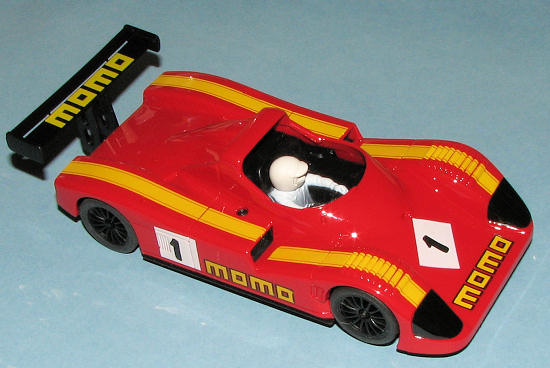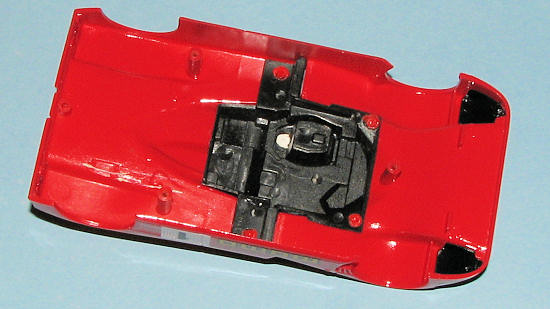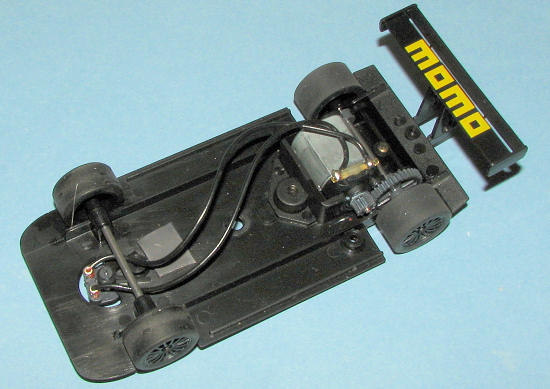
| KIT: | Fly 'Starters' 1/32 Joest Momo Porsche |
| KIT #: | 87003 |
| PRICE: | $49.95 MSRP (often found at a lower price) |
| DECALS: | None |
| REVIEWER: | Scott Van Aken |
| NOTES: | slot car |

| HISTORY |
I cannot tell you much about the actual car itself except to say that this body style on the older Porsche 956/962 chassis was developed to try to make the car more competitive. Alas, though good looking and quick, they were not as quick as their competition and so did not realize the success they would have liked.
| THE CAR |
Fly is one of many Spanish slot car companies. It seems that Spain is pretty much considered the mecca for the revised industry, at least in terms of ready to run 1/32 cars. There are several companies who operate from there. There are also companies home based in the UK (Scalextric) and in Italy (Slot.it) as well as Germany (Revell/Monogram). These latter companies all have production centers in China while the Spanish do their production at home.
 Fly
has a reputation for superbly presented cars that posses a high level of detail.
Yet their cars are usually a bit of a struggle to get to where they will
smoothly run. There are several reasons for this. One is that many cars use stub
axles in the front and these are incredibly loose, causing all sorts of rubbing.
Rubbing on the rear wheels is also an issue with many cars, requiring some
trimming to get things to fit properly. I have also had cars where the wheels
were not tight enough on the axles causing the wheels to fall off. This requires
either a new wheel or a total replacement of the axle, wheel and/or gear
assembly to cure the problem.
Fly
has a reputation for superbly presented cars that posses a high level of detail.
Yet their cars are usually a bit of a struggle to get to where they will
smoothly run. There are several reasons for this. One is that many cars use stub
axles in the front and these are incredibly loose, causing all sorts of rubbing.
Rubbing on the rear wheels is also an issue with many cars, requiring some
trimming to get things to fit properly. I have also had cars where the wheels
were not tight enough on the axles causing the wheels to fall off. This requires
either a new wheel or a total replacement of the axle, wheel and/or gear
assembly to cure the problem.
Fly also has the odd habit of placing the motor in the slot car in the same position as in the real car. This results in Porsche 911s with the motor behind the rear axle and Corvettes with the motor in the front, driving a long, spring-loaded drive shaft. Those that are the most fun to drive and easiest to get race ready are the sidewinders. These cars all have a somewhat complex rear motor carrier that is held in by one screw in the back and a small tab in the front. Means a lot of side to side wiggle and if the screw is stripped, it means more tire rubbing problems.
 Still,
many of us love Fly cars and overlook these glitches, working on the cars to get
them to run well. Perhaps this is one of the fun things about getting these
cars.
Still,
many of us love Fly cars and overlook these glitches, working on the cars to get
them to run well. Perhaps this is one of the fun things about getting these
cars.
Fly has recently introduced a new line of cars in their 'Starter' series. These cars have much less detail on them than the earlier cars, a simpler chassis and from what I see on this one, a nice, solid front axle. The result is one of the first Fly cars I've owned that will run well right out of the box with no tweaking needed.
You can see the additional simplicity once the body is off. There are only three body inserts; two headlight covers and the interior. The interior is a shortened version without a full driver figure, only a head atop the injected interior insert. This insert has nothing painted aside from the upper driver suit. There are no smaller sponsor decals on the body itself, only the number, simple paint scheme and the major sponsor. Even the paint used seems to be a bit on the thin side and it certainly is not up to Fly's usual high standards. Sort of like the third string of learners was working on it. These people must have also been heating the few mounting pins as they managed to get burn marks on the outside of the rear wing brace.
 The
chassis is also simple to the max with only three screws holding it in place
where the other style had five. The motor pod is much more securely held in
place and the motor sports a plastic pinion in place of the usual metal one.
This results is a much quieter running car.
The
chassis is also simple to the max with only three screws holding it in place
where the other style had five. The motor pod is much more securely held in
place and the motor sports a plastic pinion in place of the usual metal one.
This results is a much quieter running car.
For speed, this one is every bit as quick as the cars which are $15-25 more expensive. As with nearly all my cars, I replaced the rear tires with Indy Grip silicones, stuck a small spacer in the rear axle to keep the spur gear from possibly rubbing, and added a section of weight in the front to help keep the pickup in place. This has resulted in a very nicely running car on my Scalextric Sport track. Track speeds around the 140 foot track are in the mid to lower 14 second bracket, about a half second or more faster than other similarly powered Fly cars. Of course, it could just be luck of the draw, or a better handling car. The magnetic downforce isn't as high as on, say Scalextric, but much of that is because it uses a button magnet and that magnet is situated just aft of the center of the car. The broader bar magnets provide more pull to keep the car on the track. Removing the magnet still makes for a well handling car, though more weight is needed. This increases lap time into the 19s and 20s.
| CONCLUSIONS |
So there you have it. The question one needs to ask about this is if one is willing to save a bit of money for a less complex chassis and a much less detailed body? If the answer is yes, then this car is for you. You'll still keep the same performance and will get a nice running car in the mix.
| REFERENCES |
July 2008
If you would like your product reviewed fairly and quickly by a site that has over 300,000 visitors a month, please contact me or see other details in the Note to Contributors.